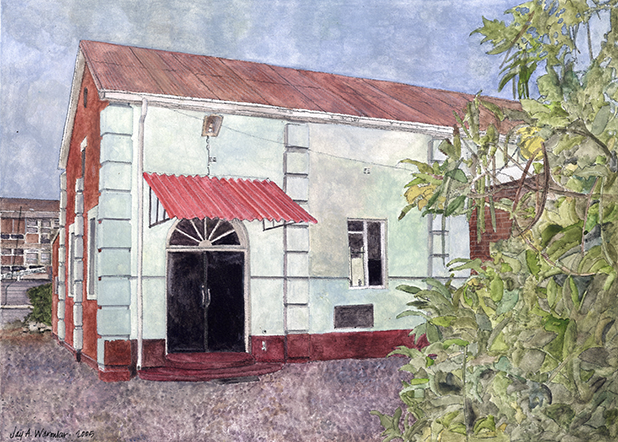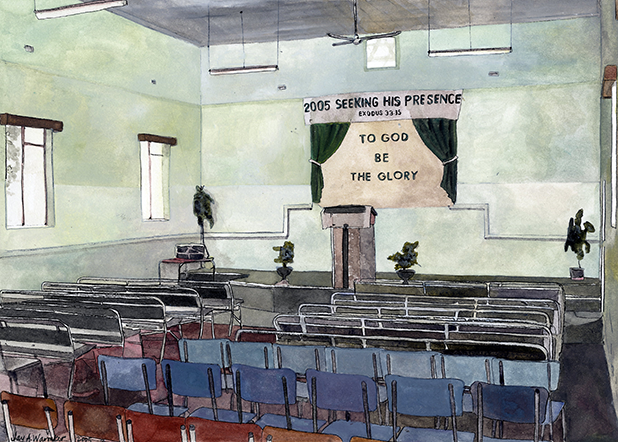 Exterior View (2005), 15” x 11” Watercolor, Jay A. Waronker
Exterior View (2005), 15” x 11” Watercolor, Jay A. Waronker
ZIMBABWE
Gweru Hebrew Congregation (Founded in 1901) Synagogue (Completed in 1933) |
|

Interior View (2005), 15” x 11” Watercolor, Jay A. Waronker
|
The modestly-scaled, painted pale mint green sanctuary building with its adjacent social hall to the right side was built by a small community of Jews of both Eastern and Western European origins. These are Jews who had settled in Zimbabwe in the late nineteenth and early twentieth centuries. At one time the country was home to more than seven thousand Jews, most living in the national capital of Harare or the second largest city of Bulawayo. Yet a few hundred Jews also settled in the central Midlands region of the country. During the late nineteenth century, Ashkenazi Jews mostly from Russia and Lithuania yet from other Eastern European countries came to settle in Zimbabwe, then called Southern Rhodesia, after the territory had been colonized and established as a trading post by Britain. Along with Harare, then Salisbury, Jews moved into Bulawayo and the Midlands area of central Zimbabwe that included Gweru, so by 1900 the Jewish population of the country was approximately four hundred strong. These were joined in the late 1930s by German and neighboring Western European Jews fleeing Nazi persecution. By 1943, the Rhodesian Zionist Council and the Rhodesian Jewish Board of Deputies were established, and shortly after World War II Jewish immigrants arrived from the United Kingdom, South Africa, and a handful of other countries. During the 1950s, the Jewish population of Zimbabwe continued to rise, and by 1961, it peaked at between seven and eight thousand people.
Rhodesian Jews became mostly assimilated into Rhodesian society, yet the community remained devout and loyal. In 1965, the white minority government of Southern Rhodesia declared independence as Rhodesia in response to British demands that the colony be handed over to black majority rule. Rhodesia then became subject to international sanctions, and Black Nationalist organizations began an insurgency which lasted until 1979. By the time the so-called Rhodesian Bush War ended, most of the country's Jewish population had emigrated along with many whites. Whereas some Jews chose to stay behind when the country was transferred to black majority rule and renamed Zimbabwe in 1980, emigration continued. By 1987, only twelve hundred Jews remained. Once social and economic conditions deteriorated further continued during the 1990s, more Jews immigrated, joining those that had earlier relocated mostly to South Africa, the United States, Israel, England, and Canada to seek better economic conditions and Jewish marriage prospects. Today less than one hundred fifty Jews remain in all of Zimbabwe, and none live in Gweru.
Initially Gweru’s Jews, who had formed a community earlier than the other Jews in the region, came to hold prayer services and other communal activities in private homes or temporary facilities. When the Jews of Gweru became large and sustainable enough to warrant a proper synagogue by the early 1930s, one was built on a prime parcel of land in the center of town on 7th Street. Its design, particularly modest, features brick walls left exposed or veneered in plaster, corner and oddly-positioned along-the-wall quoins, small metal casement windows, a gabled tiled roof, and a pair of painted entry wood doors with a half-round transom at the building’s southeast corner. The synagogue, dedicated in 1933 according to its (now gone) stone inscription, went on to serve the Jewish community for about a half a century. Although an unremarkable work of architecture, it was a well-regarded building by its congregation and a welcoming center of religious and social life for the local Jews who needed such a place.
The former synagogue sanctuary, measuring 25’ x 42’ x 16’ high, served the Jews of Gweru for some decades until the community had so declined by the 1980s and 90s that the building could not be supported. The property was sold, and over the years it functioned as an examination center, furniture warehouse, and radio station. Since 2000, the former synagogue has belonged to the Pentecostal Assembly Church. A Canadian missionary had started this church in Zimbabwe in 1948.
At the time of this painting, the rectangular space had changed little since it was a synagogue. It continued to feature its original pressed metal paneled ceiling, painted plaster walls, metal casement and fixed windows, and wooden baseboard and picture railing. The hardwood floors dating to the 1940s apparently rotted at some point, and a concrete slab was added. In more recent years, the original bulb lights hung from the ceiling were changed out to fluorescent fixtures, and some ceiling fans were added. The raised pulpit spanning the full width of the sanctuary has stayed intact along with the ark, its operable doors set flush to the wall. Now a church, the ark has sat empty and unused. Today the sanctuary is filled with a collection of mismatched seating and modest church decoration.
After independence from Great Britain in 1980, the uncertainty of a newly-established Zimbabwe, subsequent civil unrest, pronounced economic decline beginning in the mid-1980s, and the less-than-ideal social climate particularly for white citizens under the government of President Robert Mugabe, Zimbabwe’s Jewish population steadily declined during the last years of the twentieth century. By the new millennium, only a few hundred Jews remained in the country. The majority of the Jewish community emigrated to South Africa, Australia, England, Canada, or the United States. Gweru along with nearby Kadoma and Kwekwe as well as Mutare in eastern Zimbabwe were particularly affected by this change, and eventually only a handful of Jews remained in these small cities.
In 2000, Kweke’s small synagogue was sold by the Jews to the Pentecostal Assembly Church. Since then it has served this black African Christian community. The property is entirely surrounded by a wall with gate access along the main street and elsewhere, or butted up to by commercial and institutional buildings. The original inscription near the front doors was removed not long after the synagogue was converted to a church, and its whereabouts is unknown. The last local Jew, a Mr. Levitas, died in 2003, ending a period of Jewish life in this community that spanned more than a century.
When the artist of this painting, Jay A. Waronker, was in town for one night to document the former synagogue in 2005 as a Fulbright Scholar, he was approached by plain-clothed police officers just after finishing his work, questioned in hostile fashion why he was in town and photographing sensitive buildings in the neighborhood, his passport and camera were confiscated, and he was taken to the police station where he was threatened with incarceration. Finally free to go yet without his personal property, Waronker was able to telephone the US Embassy in Harare from his hotel. After many hours of nervous waiting on that Saturday afternoon, and through the intervention of the embassy staff, he returned to the police station, met with the chief of police, given back his camera and passport without apology, and was forced to spend another night in that unfortunate environment. Early the next morning on the first bus available at a time when the country was afflicted by an acute gasoline shortage, Waronker left the city that had been so unhospitable to him. He left without being able to document the very small Gweru Jewish cemetery, which during the last decade has been refurbished and maintained as best as possible.
